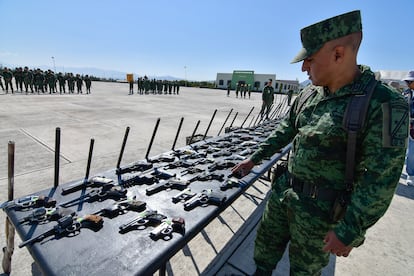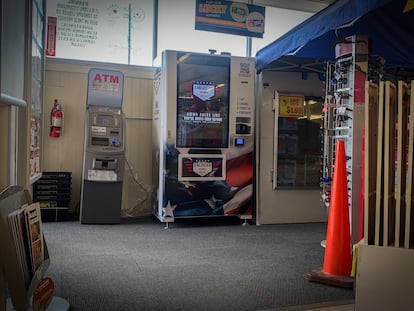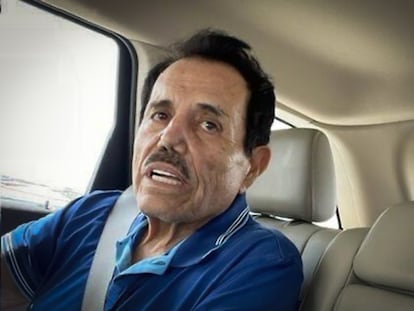Houston, Tucson and Phoenix are the US cities that are flooding Mexico with the most weapons
A recent report by the organization Stop US Arms to Mexico provides new insights into widespread illegal arms trafficking

Palmetto State Armory is currently offering Labor Day deals. An AR-15, the rifle most commonly used in mass shootings, can be purchased for 50 percent off. The bargain price of 25 cents per round is on offer for a box of 1,000 rounds of 9mm ammunition. Last chance to get a .45mm Glock for $600, says the Columbia, South Carolina-based manufacturer. Palmetto makes its mission clear on its website: “We want to sell as many AR-15 and AK-47 rifles as we can and put them into common use in America today.”
That’s the promise of a gun store that caters to gun enthusiasts obsessed with the idea that they will one day have to take up arms against a tyrannical government. Its rifles, however, fuel a war that is taking place thousands of miles away. In October 2020, the Mexican Army recovered a high-powered rifle sold by Palmetto after a confrontation with suspected hitmen in the Mexican state of San Luis Potosí. Mexican authorities have recovered 543 weapons manufactured by Palmetto over the past nine years; all of these weapons had crossed the border to swell the arsenal of organized crime.
The above case is part of The Iron River of Weapons, a recent report by the organization Stop US Arms to Mexico. It is well known that the weapons that fuel violence in Mexico come from the United States, but the document helps to understand the volume of trafficking in high-powered rifles and guns with which tens of thousands of homicides are committed each year. These are traded from practically every corner of the country. From Fort Fairfield, a town in Maine on the border with Canada, where a weapon recovered in Mexico in 2020 came from. To places like Yuma, Arizona, where 593 weapons were sold between 2015 and 2022. Of these, 591 ended up in Mexico (119 were recovered in 2022 alone). The remaining two were found in Guatemala and El Salvador.
“Weapons come from all over the country, but they are trafficked especially from cities in Texas or Arizona; border cities in these states are the most important source,” says John Lindsay-Poland, the coordinator of the report and member of the organization that released it. The five cities that exported the most weapons to Mexico between 2015 and 2022 are Houston, Texas (2,452); Tucson, Arizona (2,156); Phoenix, Arizona (1,745), El Paso, Texas (1,658) and San Antonio, Texas (1,340).
Lindsay-Poland produced the document using information obtained through legal challenges and three years of information requests from the U.S. Bureau of Alcohol, Tobacco, Firearms and Explosives (ATF). Industry lobbyists, with the help of Congress, have drawn a thick curtain that makes it difficult to trace the origin of the 250,000 firearms that make the journey south each year. The work of Lindsay-Poland and a group of attorneys helped get around a law known as the Tiahrt Amendment, which bars the ATF from sharing gun-tracing information with virtually anyone other than an enforcement agency specifically investigating a crime.

On October 1, the administration of President Andrés Manuel López Obrador will come to an end, making way for president-elect Claudia Sheinbaum. With more than 200,000 murders recorded during his six-year term, the period will go down as the most violent in Mexican history since records have been kept. With the increase in armed violence, the number of weapons recovered by Mexican authorities has also increased. This figure grew by 45% between 2015 and 2022.
The serial numbers of the rifles and guns are then sent to the ATF for analysis. They show that two out of three weapons were manufactured in the United States or came from a gun factory there. The figure could be even higher, since the country of origin of the remaining third cannot be determined because some of the gun manufacturers have plants in European countries as well as the United States. Thirty percent of the seized weapons were manufactured by four companies: Smith & Wesson, Colt, Glock and Beretta. The Mexican government has filed a lawsuit against these and seven other gunmakers seeking millions in damages caused by gun violence.
Lindsay-Poland points out that the information in the hands of the ATF also indicates that many of the weapons recovered in Mexico were previously on a secondary market. “This means that they could have been purchased in the United States in 2010 and then recovered in Mexico in 2022. We don’t know if they were circulating in the United States all that time or were already in Mexico. It is a sign of why the market must be regulated now, because it has implications in the future, in 10 or 20 years, because these weapons can kill then,” says the activist in a video call.
Over the past eight years, Mexico has recovered 800 .50-caliber rifles, weapons of war with the capability to damage armor and military structures from more than a mile away, twice the range of the AR-15. The vast majority of these are manufactured in Tennessee by Barrett. The Giffords Center says these are some of the most destructive weapons in existence and should have no place in homes or shooting clubs. Despite this, anyone over 18 who passes a background check can get one.
The Iron River report points to another problem when it comes to tracing illegal gun trafficking: the buyers. “The number of individuals who buy the guns is almost as large as the number of guns themselves,” Poland says. “It’s not just one guy working for a cartel who buys a large number of rifles. These are huge numbers,” he adds. Despite the volume, the purchases are made one by one by different individuals, called straw buyers. The 942 guns purchased in Maricopa County, Arizona, and recovered in Mexico two years ago, were purchased by 874 people. Only one in 10 individuals bought a second gun from the same seller, the report says. This is done to reduce the risk of being arrested by U.S. authorities.
The Mexican Army arms itself
Lindsay-Poland has not only obtained the information through the Freedom of Information Act. He also made requests in the Mexican system, where he learned that the Ministry of National Defense legally acquired some 62,000 firearms during López Obrador’s six-year term, from 2018 to 2023. The Army, the intermediary with the arms industry, later sold these weapons to different police corporations. They are not weapons for military use or for private individuals.
The activist warns that the Mexican government is on a buying spree at the close of the López Obrador administration. In April, May and June 2024, the country imported 10,571 military rifles from the United States, becoming the second largest buyer in the world behind Jordan. The figure is more than double the number imported by Israel (5,001), according to the U.S. International Trade Commission. The Mexican Army also imported 453 machine guns from its northern neighbor.
“Mexico continues to import extraordinary numbers of firearms. Compared to the rest of the world, the Sedena [Mexican Secretariat of National Defense] is experiencing a frenzy. I would love for someone to ask the Army what for and why now, of all times. We don’t have answers to those questions,” says Lindsay-Poland.
Stop US Arms to Mexico believes that the United States does not respect the foreign policy principle that prevents selling weapons to those who have committed violent crimes, including institutions that have violated human rights. “There are many police agencies in Mexico that are in collusion with organized crime. There are units of the Navy and the Army that are in collusion, not by supplying them with weapons, but by manipulating by strengthening or weakening different organizations in their home places,” explains Lindsay-Poland.
This expert believes that the sale of weapons abroad should follow the same guidelines as the regulation within the United States. “The criminal record will look for evidence that you have committed a crime, and not only that, it will look for restraining orders in case you have been violent with a partner. If there are such precedents, they will not sell you weapons,” he maintains. For the moment, the river of weapons to the south seems to have no brakes.
Sign up for our weekly newsletter to get more English-language news coverage from EL PAÍS USA Edition
Tu suscripción se está usando en otro dispositivo
¿Quieres añadir otro usuario a tu suscripción?
Si continúas leyendo en este dispositivo, no se podrá leer en el otro.
FlechaTu suscripción se está usando en otro dispositivo y solo puedes acceder a EL PAÍS desde un dispositivo a la vez.
Si quieres compartir tu cuenta, cambia tu suscripción a la modalidad Premium, así podrás añadir otro usuario. Cada uno accederá con su propia cuenta de email, lo que os permitirá personalizar vuestra experiencia en EL PAÍS.
¿Tienes una suscripción de empresa? Accede aquí para contratar más cuentas.
En el caso de no saber quién está usando tu cuenta, te recomendamos cambiar tu contraseña aquí.
Si decides continuar compartiendo tu cuenta, este mensaje se mostrará en tu dispositivo y en el de la otra persona que está usando tu cuenta de forma indefinida, afectando a tu experiencia de lectura. Puedes consultar aquí los términos y condiciones de la suscripción digital.
More information
Archived In
Últimas noticias
David Bowie, the galactic thinker who encouraged us to break new ground
John Berger and the loss of rural culture
From police officer to bloodthirsty kidnapper: Terror in Mexico during the years of ‘The Ear Chopper’
Alain Aspect, Nobel laureate in physics: ‘Einstein was so smart that he would have had to recognize quantum entanglement’
Most viewed
- David King, chemist: ‘There are scientists studying how to cool the planet; nobody should stop these experiments from happening’
- Reinhard Genzel, Nobel laureate in physics: ‘One-minute videos will never give you the truth’
- Oona Chaplin: ‘I told James Cameron that I was living in a treehouse and starting a permaculture project with a friend’
- Sinaloa Cartel war is taking its toll on Los Chapitos
- Mexico completes its trade shift with the entry into force of tariffs on China and countries without trade agreements










































